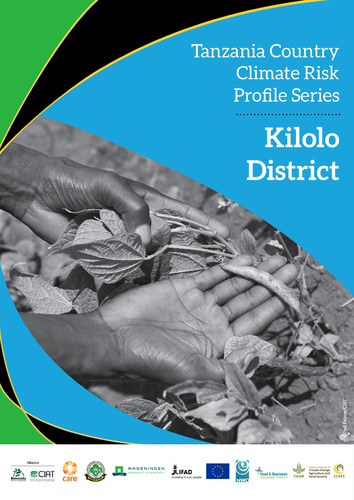Tanzania Country Climate Risk Profile Series, Kilolo District
The agricultural sector in Tanzania has been exposed to high climatic risks for the past several decades (Arce & Caballero,
2015). Experts and farmers assert that climatic risks including unpredictable rainfall, prolonged drought, and increased incidences of pests and diseases have resulted in declining agricultural productivity. Concomitantly, the rivers, streams, soils, and forests from which the rural poor build their livelihoods are on the verge of depletion. The situation has been further exacerbated by unstable commodity prices. Future climatic projections show that the climate trends are likely to worsen in the coming years. For instance, mean annual temperatures in Tanzania are predicted to increase by up to 2.7°C by 2060, and by close to 50% by 2090 (Irish Aid, 2018). Similarly, day and night temperatures are also expected to increase. Rainfall will become increasingly erratic both locally and regionally, with both floods and droughts growing in intensity and frequency. Smallholder farmers have the poorest access to resources such as land tenure, water resources, crop and livestock insurance, financial capital, and markets, and thus are the least risk-resilient. Women farmers in particular suffer systematic discrimination in terms of access to these
resources. Women are also culturally expected to execute the most laborious agricultural tasks in addition to their household responsibilities of caregiving, preparing meals, and collecting fuel and water. Meanwhile, men tend to be responsible for tasks involving financial exchange, such as land acquisition, sourcing capital for production, purchasing and applying chemicals, and identifying buyers. This cultural norm is reinforced by the tenure system, which assigns land ownership almost exclusively to men. These factors make women the most vulnerable sub-group of smallholder farmers (Irish Aid, 2018). The national government, donor community, private sector, and development partners have invested in helping households prepare for such climate scenarios. A number of policies, strategies, programmes, and guidelines have been documented with the goal of boosting the adaptation capacity of vulnerable groups. Prominent among these are the National Agricultural Policy (NAP 2013), the National
Climate Change Strategy (NCCS 2012), the National Adaptation Programme of Action (NAPA 2007), and the Climate-Smart Agriculture implementation guideline. Despite these efforts, several issues remain unaddressed due to a lack of coordination among relevant actors. The development of a local Climate-Smart Agriculture Profile can support the clarification of roles and crucial points of coordination to assist in this effort. This Kilolo District profile thus underscores the climate-smart agriculture
(CSA) investments undertaken by farming households in the region. This profile is an output of the CSA/SuPER project on
Upscaling CSA with small scale food producers, organized via the Village Saving and Lending Association (VSLA) Project,
and implemented by Cooperative Assistance and Relief Everywhere (CARE International), the International Center for Tropical Agriculture (CIAT) (now part of the Alliance of Bioversity International and CIAT), Sokoine University of Agriculture, and Wageningen University and Research. Both qualitative and quantitative methods were used to gather the information herein, in accordance with the methodology employed by Mwongera et al. (2015). Secondary information was collected through an extensive literature review. Primary information was collected from interviews with agricultural experts, farmer focus group
discussions, stakeholder workshops, and farmer interviews in Kilolo District. This profile is organized into six major sections based on the analytical steps of the study. The first section describes the contextual importance of agriculture to Kilolo livelihoods and households. The second describes historic and future climatic trends. The third section highlights farmers’ priority value chains. The fourth section addresses the challenges and cross-cutting issues in the sector. The fifth section details climate hazards experienced by farmers, as well as the current and proposed adaptation strategies. Finally, the sixth section outlines the policies related to CSA and the institutions that facilitate implementation of climate change initiatives.

